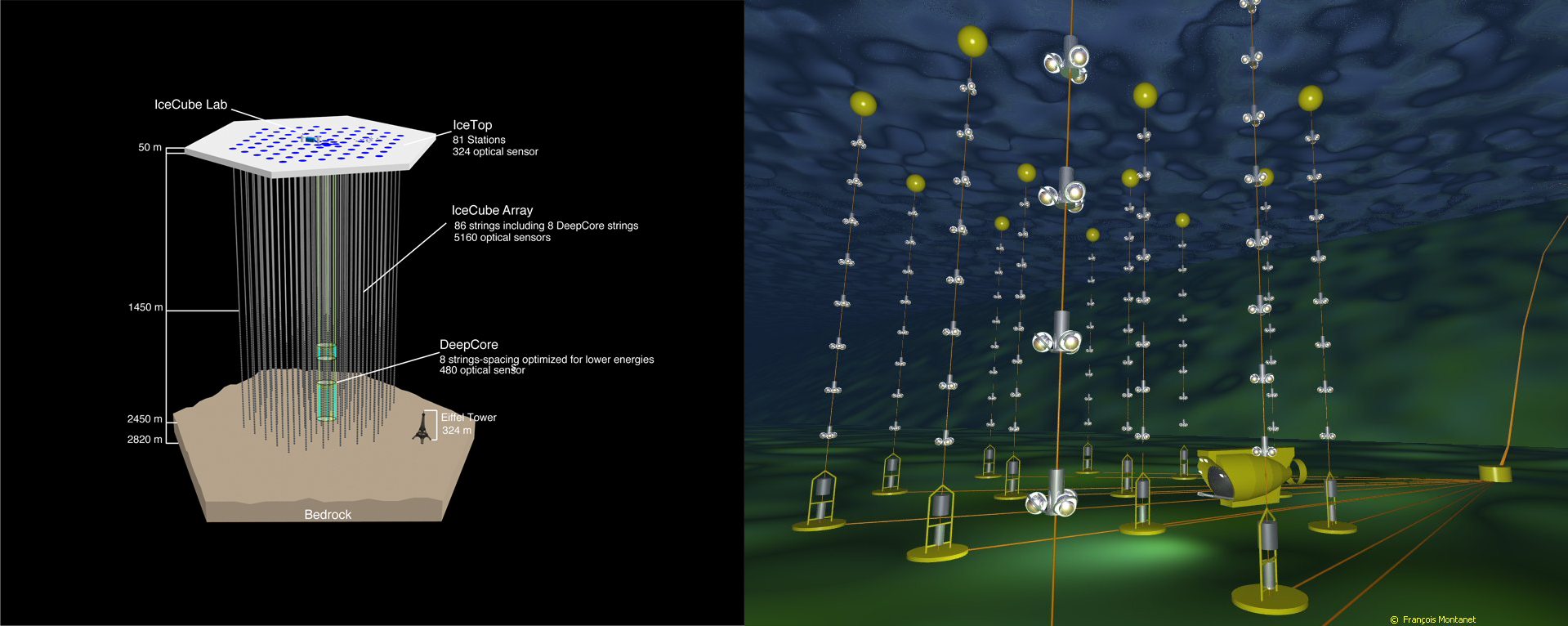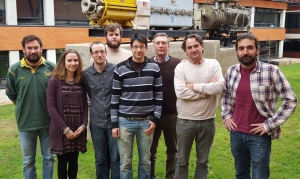IFIC leads the search for cosmic neutrinos using two telescopes in Antarctica and the Mediterranean
New step forward in “multi-messenger astronomy”. The prestigious magazine The Astrophysical Journal publishes a joint study of the IceCube and ANTARES experiments to search for neutrinos of astrophysical origin. These are two of the main “telescopes” in the world that search for this type of elementary particle, which contains valuable information on the places in the cosmos where they occur, such as in the vicinity of black holes or in supernovae. The study is led by Giulia Illuminati, a predoctoral researcher at the Corpuscular Physics Institute (IFIC, CSIC-University of Valencia), a research centre that leads the Spanish participation in ANTARES and its successor, KM3NeT.
Astronomy no longer observes the universe only through the electromagnetic spectrum (light, infrared, or radio waves). Advances in physics and technology allow other sources such as neutrinos to be used. This type of elementary particle is a faithful messenger that contains valuable information on the places where they occur, extreme phenomena of the universe such as supernovae or black holes. Due to their peculiar characteristics (they have no electric charge and hardly any mass), neutrinos travel directly to us from their origin, making them a very useful tool to identify where these events occur.
However, their properties also make them very difficult to be detected. To do this, the experiments that look for them use large volumes of matter and hope that one of these neutrinos of astrophysical origin interact by leaving a signal in their detectors. One of them is IceCube, which deploys more than 5,000 optical detectors in a cubic kilometre of Antarctic ice. Another one is ANTARES, which has nearly 1,000 detectors at the bottom of the Mediterranean Sea, off the French coast.

Both have been collecting data for more than a decade. IceCube was the first experiment capable of detecting very high energy neutrinos, whose origin was outside of our solar system. Furthermore, it was the first telescope to observe a compelling association of astrophysical neutrinos with an individual cosmic source, the blazar TXS 0506 + 056 (a blazar is a highly compact and variable energy source associated with a black hole at the centre of a galaxy). However, the origin of most of the astrophysical neutrinos observed by IceCube remains unknown, prompting further study.
This is where the work carried out by Giulia Illuminati in the ANTARES-KM3NeT group at the Corpuscular Physics Institute becomes important. The predoctoral researcher has led up to five analysis that combine data from IceCube and ANTARES to search for the origin of astrophysical neutrinos. “The reason for doing this is that the two telescopes complement each other thanks to their different characteristics, in particular the larger volume of IceCube and the privileged view of the sky of the Southern Hemisphere from ANTARES”, explains Illuminati.
The first two analysis consisted of a full exploration of the Southern Hemisphere sky and a restricted region around the centre of our galaxy, where a supermassive black hole is believed to be. In the third analysis, they investigated the positions of a list of 57 astrophysical objects known for their gamma-ray emission (which is also associated with the production of neutrinos). Finally, they conducted two searches for the location of two promising candidates to be neutrino sources: the Sagittarius A * radio source (associated with the supermassive black hole at the centre of the Milky Way) and the supernova remnant RXJ 1713.7-3946.
“Since the surroundings of supermassive black holes are a site where acceleration of very high-energy cosmic rays most likely occurs, and therefore potential sources of cosmic neutrinos, Sagittarius A*, located in the centre of our galaxy, is a candidate of particular interest”, justifies Illuminati. For their part, “supernova remnants are the most promising candidates for the acceleration of galactic cosmic rays. Therefore, the supernova remnant RX J1713.7–3946, which is the brightest object of this type in the sky observed in gamma rays with TeV energies, represents a particularly interesting target for the search for cosmic neutrinos”, she points out.
Although the analysis did not find any significant neutrino emissions from the explored sites, they have served to demonstrate the potential of conducting joint searches with both experiments to make future discoveries. “To discover a source of neutrinos in the galactic centre area we would only need to observe half the neutrino flux compared to what each experiment must observe separately”, says the IFIC researcher. This involves doubling the sensitivity of both experiments together. With the launch of KM3NeT, which will deploy more than 10,000 sensors at various sites in the Mediterranean and whose first lines have been installed and are collecting data, and the next improvement of IceCube, the potential of joint analysis seems clear.
More information:
“ANTARES and IceCube Combined Search for Neutrino Point-like and Extended Sources in the Southern Sky”, ANTARES and IceCube Collaboration, The Astrophysical Journal, Volume 892, Number 2
https://iopscience.iop.org/article/10.3847/1538-4357/ab7afb
https://arxiv.org/abs/2001.04412
ANTARES and IceCube combine forces to search for southern sky neutrino sources




















